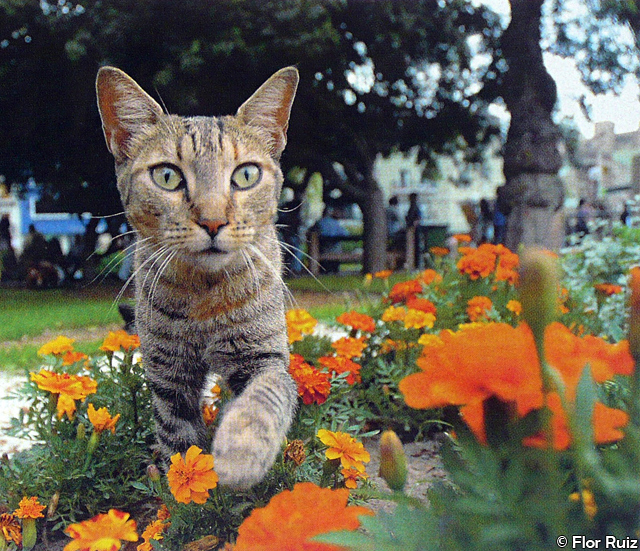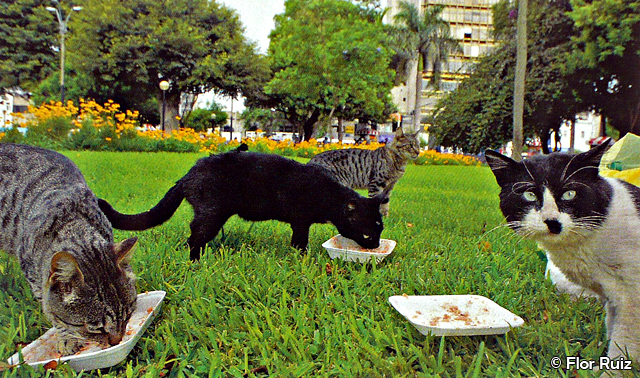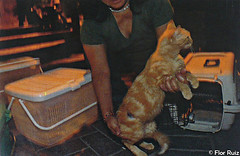The Cats of Parque Kennedy
Parque Kennedy, the heart of Miraflores, is home to painters, artisans, sellers of balloons and of delicious picarones. It is also home to around fifty cats that delight onlookers and tourists alike. But not everyone is so easy to impress – a group of neighbours, you know their type, has taken to complaining about them. “Who feeds them? Who vaccinates them? They’re a health hazard!”, go the complaints, leading to a confrontation between those who defend them and those who want them ‘disposed of’.
Text by María José Fermi, Photos by Flor Ruiz for El Comercio
A tiny woman passes between the trees of the park, moving quickly for someone who has two large bags to carry. As she arrives to one particular tree, a group of cats make their way towards her across the grass. They know it’s lunch time. Mariana has been feeding the dozens of cats that live here religiously for 16 years, five times a week. Although she lives in Surco, she brings the food – a mix of chicken liver, rice and commercial cat food – each day without fail. She places and recollects plates on the ground before taking the bus back home. No-one obliges her to do this, she does it out of love for the stray animals that live here.

The cats also recognise Charo. As soon as they see her they run towards her without the fear they have of the other people who pass through the park. She’s been feeding the cats here since 2004. From about that date she joined with other people to form a group to help the cats, a group that now has 14 members who take turns to feed, give vaccinations, provide veterinary care and generally raise money.
Mariana and Charo are not the real names of these two kind strangers. They prefer to remain anonymous – the fear reprisals by those who disagree with their actions.
Long time residents
No-one really knows how the cats came to be here. Some say that once a woman abandoned her pregnant cat in the park and from there they started reproducing. Others say they that they came from the church located in the centre of the park, that they let their cats roam free in order to deal with a rat problem that they used to have. What we do know is that these cats have been here, according to testimony from the older Miraflores residents, for at least 20 years.

Just as there are those who love and what to protect them, there are those who detest them and even try to hurt them. In fact, three cats were recently found dead.
On the on-line community websites that well known by those who live in the Lima district of Miraflores, the discussion of what to do with the cats is never ending.
The cats are nice but they should be vaccinated, there could be health considerations.
Its not right to have disgusting creatures fighting in the middle of the park while our children are playing. The park is a breading ground for bacteria!
Others complain that the cats make the park look “messy”.
Those cats are an unhealthy plague that make the area dirty. Their extermination is a question of order and cleanliness.
Some comments are more extreme.
Just seeing them makes me what to boil them all in a pot… Poison them and make them disappear!
Here’s a slightly different quote, though not from the community website:
The greatness of a society and its moral progress can be judged by the way it treats its animals. ~Mahatma Gandhi
Health concerns
The principal argument of the cat-haters is that there is a possibility of transmission of illnesses to humans.
Vet Alicia Rubio explains that the cats could potentially pass parasites on to humans if they are in direct contact with their faeces.
“There’s no way you can contract parasites from the air. Not only does there have to be direct contact, but the person must also ingest the parasite to become infected”.
The majority of these parasites, she explains, pose no threat to humans. In other cases they can indeed cause various health problems. For Rubio though, the chances are slim.
“For a cat to transmit taxoplasma gondii for example, the cat would also have to be infected. To become infected that cat would have had to have eaten the faeces of an infected cat or the raw meat of an animal with the parasite.”
She explains that so long as the colony of cats are given cooked food they are unlikely to become infected. Should the neighbours complaining about the cats refrain from eating cat faeces, as well as wash their hands before eating after touching any of the cats, there is no health risk.
 Those who like the cats explain that they have de-parasited, vaccinated and sterilized most of the cats, paid for out of their own pockets. They have joined with a young vet who also wanted to help the cats so that all the veterinary services can be provided at al low cost. She also prefers to remain anonymous due to threats.
Those who like the cats explain that they have de-parasited, vaccinated and sterilized most of the cats, paid for out of their own pockets. They have joined with a young vet who also wanted to help the cats so that all the veterinary services can be provided at al low cost. She also prefers to remain anonymous due to threats.
Each week, she explains, two or three cats are captured and taken to her clinic where they are given any healthcare they need and time to recover, before being returned. The technique, “Trap-Neuter-Return” is practised throughout the world to control numbers of strays.
Refuge and cleanliness
Those who complain about the cats direct their complaints to the Municipality of Miraflores who take no part in feeding the animals but have implemented ideas to both care for them and at the same time calm neighbours distressed to the point of hysterics by their mere existence.
 The park is cleaned and disinfected twice a day, using products safe for the animals but that remove and bad odours. The municipality also oversees the groups who capture the cats for medical treatment and deparasitation. They are looking into the possibility of helping with these costs under the pretence that the cats provide a valuable service against plagues of rats, for which the park was famous for in the 1980s before the cats lived here.
The park is cleaned and disinfected twice a day, using products safe for the animals but that remove and bad odours. The municipality also oversees the groups who capture the cats for medical treatment and deparasitation. They are looking into the possibility of helping with these costs under the pretence that the cats provide a valuable service against plagues of rats, for which the park was famous for in the 1980s before the cats lived here.
What is agreed by all is that the number of cats in the park should not rise above what it is today, which is an estimated 80. The current situation is manageable, but with every count are appearing more and more.
In recent days, three cats have been found dead in the park. Pet poisoning and animal cruelty is a big problem in Peru.
According to some, pet owners who no longer want to care for their animals have taken to abandoning them in the Parque Kennedy. There have been cases of the abandonment of pregnant cats and well as large numbers of kittens. Everyone agrees that this should not occur, and although the municipality have created a team to deal with the treatment of pets in the district, only two officers have been assigned to the area of the park. The abandonment of pets by owners, a practice that may have brought the cats to the park in the first place, will have to stop before the number of animals becomes a problem.
Tags: middle class, miraflores, parque kennedy, stray dogs










